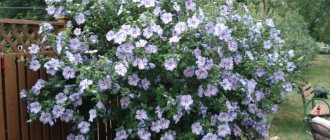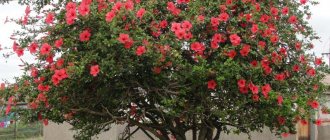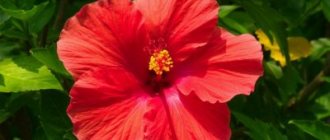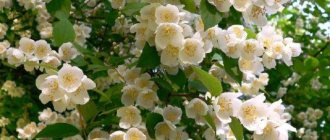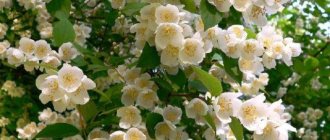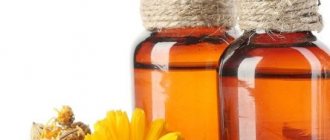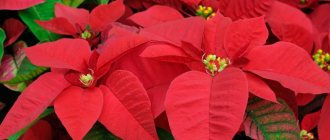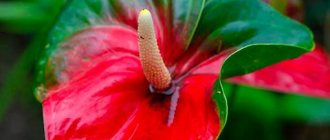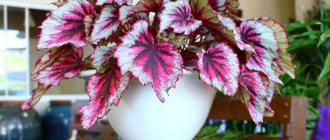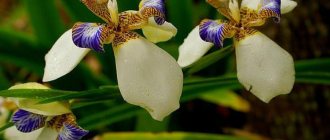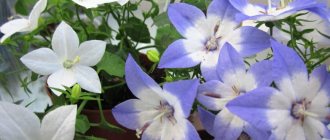Hibiscus is one of the subtropical evergreen plants with spreading branches and delicate rosette-shaped flowers. The second name that has stuck is “Chinese rose”. Many flower growers have known it since the times of the Soviet Union, when beautiful shrubs with delicate scarlet flowers decorated the halls of film clubs, library halls and apartments. However, many facts have been collected around hibiscus, some true and some not so true. We’ll tell you in more detail why it was nicknamed “the flower of death,” how to properly care for this plant when grown indoors, and what benefits hibiscus can bring.
Botanical characteristics of hibiscus
The morphological, physiological and environmental parameters of this plant are represented by the following characteristics:
- Ecological group – perennial (rarely annual, for the herbaceous form) evergreen shrub, a woody form of life is also found;
- Department: Flowering plants;
- Class: Dicotyledons;
- Family: Malvaceae;
- Genus: Hibiscus (Hibiscus);
- Leaves: petiolate, more or less incised with reticulate venation, leaf blade simple;
- Flowers simple or double;
- Fruit: five-leaf capsule with smooth or slightly hairy seeds. Seeds are contained in large quantities.
Why is hibiscus called the “flower of death”?
Many beliefs, signs and legends have long gathered around hibiscus. The beauty and large size of the flowers attracted not only lovers of flowering plants, but also warlocks, sorcerers, and witches. This brought only bad, unproven fame. Constant and long-term observations of people over the annual development cycle of the plant have borne fruit: they have established that hibiscus blooms at approximately the same time - from April to September. However, there have also been abnormal cases of flowering. If suddenly a hibiscus suddenly bloomed at an out-of-hours time, according to the generally accepted opinion, unpleasant coincidences would occur: someone would inevitably die during the period of unexpected flower activity.
Since then, it has become common knowledge that this behavior pattern of the Chinese rose serves as a harbinger of serious illness and death. An even worse sign was considered to be the sudden withering and drying of this plant, as they say, out of the blue for no reason. People began to assume that the flower has internal magic, energy vampirism, and sucks the vitality out of weak people. Therefore, if such a flower stood in a house where a person was seriously ill, the plant was superstitiously taken out or rearranged to avoid direct contact of the patient with the “harbinger of death.”
Of course, the plant is not to blame for anything, and all the troubles are just the result of sad circumstances and long-standing superstitions passed down from generation to generation. When thinking about cultivating hibiscus at home or in the garden, do not despair - it will not cause you harm, and the flowering period when grown far from the homeland of this species is not strictly established. There is no need to look for hidden meaning where there really is none. Most often, flowering and wilting are affected by several simple reasons that literally lie on the surface: improper care, insufficient or excessive watering, short daylight hours, poor substrate and lack of mineral and organic substances, severe pruning and manual formation of the crown.
These are factors that determine the timing of flowering, and with proper care, hibiscus can delight you and your household with flowering almost all year round, and in open ground - throughout the summer season. Another reason for drying and yellowing of leaves and shoots may be that the hibiscus root system is affected by pests. As a result, the function of nutrition and root absorption was disrupted due to damage to the conductive vessels.
The end of the white streak in life begins with the death of the hibiscus
Another superstition related to why the Chinese rose is the flower of death. Perhaps this is explained by the fact that the transience of flowering provokes the appearance of sad thoughts about the natural fading of the beauty of any living creature.
But it is worth remembering that this is the same biological process that occurs according to its own rules. One bud of an ordinary hibiscus usually blooms for no longer than one day. Fortunately, others come to replace it, and an adult plant produces several flowers at the same time. And if the right conditions are created, the hibiscus will bloom constantly.
Known types and varieties of hibiscus
Kinds
The most famous of the hibiscus are three main botanical species that have been used in the breeding of popular modern varieties. These are Chinese hibiscus, double hibiscus and Hawaiian hibiscus. In addition to them, there are other species, including wild ones. In total, according to modern classification, there are more than 300 wild species of natural origin, and with the help of modern selection methods, about 500 new varieties and various forms of hibiscus have been bred, the main differences of which are observed in the color of the petals, the shape and size of the flowers, the shape of the leaves and the density of the crown.
Chinese hibiscus ("Chinese rose")
The Latin name is Hibiscus rosa-sinensis. Initially found in the wild: the natural habitat and distribution of the species are considered to be the islands of the Pacific waters and the subtropical regions of East Asia. It is an evergreen non-deciduous plant, the height of which varies up to 4 meters. Young shoots are green, but at a more “mature” age they undergo lignification and become brown.
Hibiscus tree (Syrian)
Latin name: Hibiscus syriacus. This perennial species is native to countries such as India and China. The plant has dense, succulent foliage with a beautiful bright green hue. The peculiarity is in the natural variegation of foliage, which adds zest to the overall morphological appearance of the hibiscus as a whole. It is characterized by a long life expectancy - about 100 years under normal water and climate conditions. At the same time, it grows very slowly, blooming only in the second year of cultivation. The main purpose of using this species in gardening is to create hedges, fences and shrub compositions. Quite frost-resistant, can withstand air temperatures down to -22 degrees Celsius.
Hibiscus hybrid
Latin name – Hibiscus hybridus. Perennial, evergreen. A very heat-loving hibiscus. From the name it becomes clear that this variety is the result of the work of breeders. Hybrid hibiscus is derived from North American wild hibiscus species. It has very large, bright and spectacular inflorescences. Thanks to them, this species has become widely used in the design of flower groups, borders, and the coasts of water areas. For good flowering and protection from cold, it requires shelter for the winter, autumn hilling after the end of the generative season, and in the spring, hybrid hibiscus needs crown pruning to force out new shoots and renewal. Successfully propagated by cuttings, dividing the bush, grafting.
Popular varieties
There are a great many varieties of hibiscus, about 500 pieces. Their main difference depends on the species initially used (the base plant, which is influenced by selection methods to obtain a new morphological, physiological and genetic related form) and the final color and shape of the flower. We will use these characteristics further when describing popular varieties of hibiscus. Admire with us and take a closer look, perhaps among them there is exactly the one you have been looking for for a long time!
Albus
A variety based on hybrid hibiscus. The crown is spreading, the foliage is variegated. Blooms with large white flowers. Flowers are solitary.
Diana
A popular variety with strong and robust shoots. Features interesting flowers. They are white in color, with pronounced wavy edges of the petals, making the flower look “curly.”
Russian Violet
A variety based on hybrid hibiscus. It blooms with bright pink, almost crimson flowers with a simple perianth.
Michurinets
A variety of domestic Russian selection based on hybrid hibiscus. The flowers have a bright crimson hue.
Digital Camera
Chaikovsky
An interesting variety based on hybrid hibiscus. Long-lasting blooms, emerald foliage and purple flowers make an excellent combination for indoor growing.
Snowflake
Another Russian hybrid beloved by gardeners. The flowers are white.
Ardens
A variety based on Syrian hibiscus. The heavily double flowers range in shades from purple to violet with a burgundy-red center.
Woodbridge
The base for the variety was Syrian hibiscus. The flowers of this hybrid are simple, dark crimson. There is a small dark red spot in the middle.
Lady Stanley
An excellent variety for those who love double flowers in hibiscus! The buds have a pink-white tint, the middle is dark red. Highly double.
Ankara
Hybrid based on Chinese hibiscus. The flowers are yellow in color, with a bright accent – the red core of the flower inside.
OLYMPUS DIGITAL CAMERA
Flamingo
A variety bred from Chinese hibiscus. A spreading bush with simple pink flowers and a dark red center.
Bari
Another successful hybrid of Chinese rose. It blooms with single flowers of a bright yellow hue, with a red core inside.
Description
The homeland of the Hibiscus plant (Chinese rose) is supposedly Asia Minor, but the flower grows in China, Korea, and India.
Under natural conditions, it is most often a shrub (sometimes three meters high!) with smooth gray branches.
Hidden in the cool green crown are large flowers with the thinnest, almost transparent petals of various colors in white-pink-red tones, from soft white to dark crimson.
And not so long ago, flowers appeared even with shades of blue - the so-called “Florida” hibiscus. The lifespan of each flower is short, only one day. But every morning the miracle repeats itself: new flowers appear from the buds.
On our website you can also find advice from gardeners on the following topics: fertilizing, pruning, flowering, reproduction, diseases.
Hibiscus Facts: What is this plant known for?
Despite the erroneous dark fame of hibiscus, based on human superstitions and prejudices, hibiscus is very useful. The scope of its application is quite extensive, and the variety of facts collected from all over the world is pleasantly surprising. Do you know that:
- In Malaysia, hibiscus has the status of national flower;
- In the United States of America, an interesting thematic society has existed and operated successfully since 1950. What do you think his activities are related to? It's called the Hibiscus Society!
- Hibiscus is actively used in cooking, since all parts of the plant are suitable for consumption except the root: stems, leaves, flowers. For example, a vegetable or mixed salad can be prepared on the basis of the leaves; meat can be stewed with them. Seeds are an alternative solution to the widespread use of tired sesame. Confectionery products are baked with them, added as a ground spice to coffee and drinks, and also used in snacks and salads as an additional spice;
- Hibiscus flowers are the most popular structural part of the plant and are eaten. The petals are used to prepare the well-known red tea with a pleasant sourness - hibiscus. The uniqueness of the petals is that they retain color when dried due to the large number of coloring pigments, anthocyanins. The hibiscus drink has a rich ruby hue, is very healthy, contains a lot of vitamin C, due to which that distinct sourness is felt in the taste;
- Hibiscus flowers are used in the practice of dyeing fabrics - anthocyanin pigments, which are part of the perianth cells, act as a natural and persistent dye;
- Chinese rose flowers are widely used in medicine. Their properties are numerous: infusions and medicinal drinks based on the structural parts of flowers have an antiseptic and antispasmodic effect, have a diuretic effect, and normalize blood pressure. Due to the content of phytoncides, hibiscus is included in antiparasitic agents, causes an anthelmintic effect, and removes toxic and side metabolic elements from the body;
- Hibiscus contains a large amount of oxaloacetic acid (OA) and linoleic acid. Drinking teas with hibiscus in this case prevents the formation of cholesterol plaques and normalizes the functioning of the urinary system;
- Hibiscus seeds are used by local people in the Pacific Islands and Asian countries to make necklaces;
- In China, one of the cities is named after a flower - Chengdu. Literally translated, it means “city of hibiscus”;
- Hawaiian women can be proud that they have become a symbol of beauty and their association with hibiscus, as they love to use the flowers to decorate their hair and to make flower necklaces, which is why it is called “the flower of beautiful women”;
- The Fiji Islands have a national holiday called “Fire Hibiscus Day” in honor of this plant. During the festival, the streets are decorated with garlands of flowers, and processions of young girls dressed in decorations made from the same hibiscus flowers pass through the streets dancing and singing.
In what form is it sold, how to choose a quality product
Hibiscus is a popular flower tea, so there are many forms available. For example, in bulk, in bags, as part of a blend or herbal mixture. The healthiest option is to buy by weight and where it was grown. Quality is easy to define. High quality Hibiscus tea consists of large identical petals. Crumbs and third-party fragments are not allowed in its composition.
All hibiscus petals for hibiscus should be a uniform burgundy color. If the petals are very dark, almost black, this means that the tea is too dry. A pink or scarlet tint indicates immaturity and poor growing conditions. Sudanese rose loves sun and moisture. She cannot stand cool and cloudy weather.
A properly dried hibiscus petal is fragile and brittle. If you press it with your fingers, it crumbles and crunches. If the petal is wrinkled, it means that the manufacturing technology is broken, or the tea was stored incorrectly and it became saturated with moisture. In this case, the drink turns out tasteless and has much less benefits.
If Hibiscus is smooth, beautiful and fragrant with roses, then the tea it makes is aromatic, tasty and very healthy!
Hibiscus also needs to be stored correctly. After all, its taste and healing properties depend on this. Store hibiscus tea in a dark place, in a glass container or linen bag. There should be no heat sources or products with sharp or strong odors near flower tea.
Video on how to plant and care for hibiscus
Types of hibiscus, when and how to plant it correctly. Flower propagation by seeds and cuttings. Pests and diseases of hibiscus, effective methods of controlling them. Join the viewing!
Hibiscus is a good solution for lovers of spectacular indoor plants and experimental gardeners who are not afraid of possible difficulties. By providing good care for the flower and placing it in an open, illuminated place, you will provide home comfort, enjoy long-term flowering and get a real “green doctor” for the air in your room! All the best on your journey of growing hibiscus!
Reproduction methods
Propagation of hibiscus by seeds
| |
Propagation by cuttings
|
